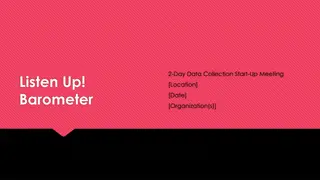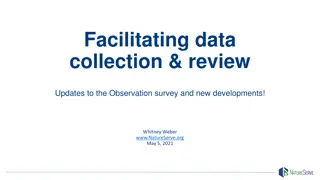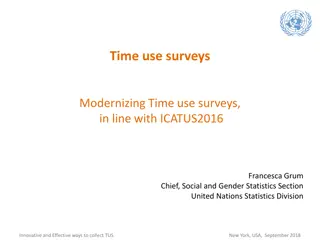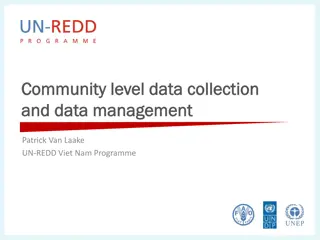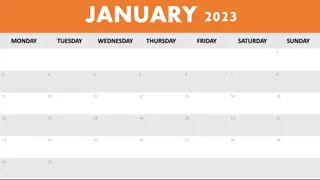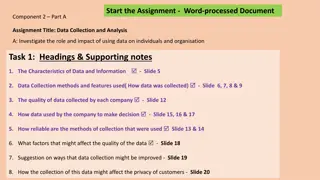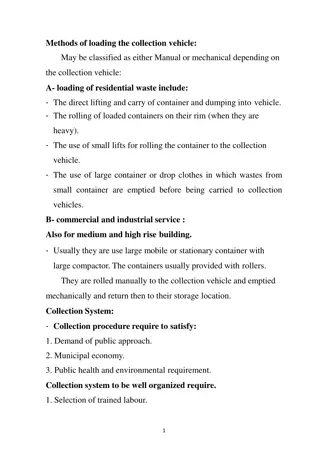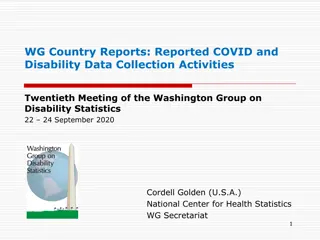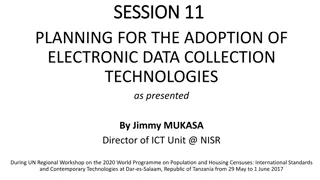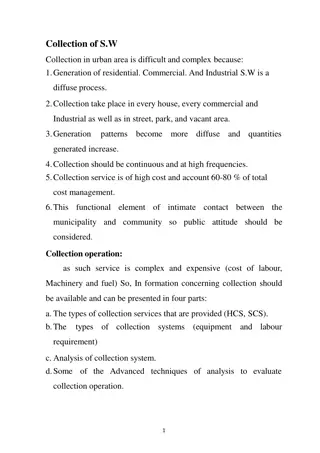
Effective Data Collection Strategies in Health Research
Learn about the essential steps in health research data collection, including designing research methodology, conceptualizing research processes, defining survey purposes, identifying research topics, and listing variables to measure for patient satisfaction assessment.
Download Presentation

Please find below an Image/Link to download the presentation.
The content on the website is provided AS IS for your information and personal use only. It may not be sold, licensed, or shared on other websites without obtaining consent from the author. If you encounter any issues during the download, it is possible that the publisher has removed the file from their server.
You are allowed to download the files provided on this website for personal or commercial use, subject to the condition that they are used lawfully. All files are the property of their respective owners.
The content on the website is provided AS IS for your information and personal use only. It may not be sold, licensed, or shared on other websites without obtaining consent from the author.
E N D
Presentation Transcript
Day 5: Data collection SIOAPE KUPU HEALTH RESEARCH OFFICER
Research process The 3rdand 4thstep: Design and Collecting Data involves creating your Research Methodology and Methods and then collecting the data.
Quick Refresher on Research Process Firstly, we need to conceptualize limit it to the main applicable points; conceptualize, it is quite comprehensive but I will 1) Identify the purpose 2) Identify the topic 3) Identify the variables and concepts we wish to measure 4) Decide on your Methodology 5) Create research questions or hypotheses
1. Purpose What is the purpose of this survey? Explanatory Explanatory Establish causation or association Descriptive Descriptive Describe or a snapshot of a situation Exploratory Exploratory Get some basic ideas of an area not clearly defined.
2. Topic What What is the topic of interest is the topic of interest? ? Patient Satisfaction Why? Why? Patient satisfaction is a key determinant of quality of care and an important component of staff performance. Who are we targeting? Age Who are we targeting? Age- -group? Certain demographics? group? Certain demographics? Which health service? Area of distribution? Which health service? Area of distribution?
2. Topic It s important to define what you re going to do with the information. Knowing how you ll use the data also helps you determine what questions you re going to ask.
3. Variables to be measured List all possible aspects or dimensions of the concept to identify the different components for which you will be generating items - questions. For example, we wish to identify what patient satisfaction is. What is patient satisfaction? What areas of patient satisfaction can we measure or should be focused on? Research contests that Patient Satisfaction is already a very broad aspect and quite tricky to measure and is not easy.
Doctor- Patient Care/ Service Delivery <Dimension> Medication <Dimension> Nurse-Patient Care/ Service Delivery <Dimension> PATIENT SATISFACTION PATIENT SATISFACTION <CONCEPT> <CONCEPT> Health-care environment <Dimension>
4. Decide on your Methodology Now that you have your Research Question! What is your plan of action or your strategy to tackle the Research Question? At the moment you are limited to one choice! Quantitative Cross-Sectional Surveys However, in Request for Proposals (RFPs) you can use any Research Methodology deemed appropriate to your Research Question including; 1) Observational Longitudinal Study 2) Case-Control 3) Ethnography 4) Phenomenology Etc.
5. Research Question Question based on topic and concept with variables in mind! *Are the elderly diabetic patients (age 45+) in the Surgical Ward satisfied with the current nursing service delivery for 2014? *Has the Kau Mai campaign improved female Tongans (15+) attitudes towards healthy lifestyles?
Day 5: Data Collection: Questionnaire Development DESIGNING YOUR QUESTIONNAIRE AND DELIVERING IT!
Day 5 Objectives 1) The Process of Selecting a Variable s Measurements 2) Types of Constructs and Variables 3) What makes a good measure/variable? 4) What is a Sample and Why we Sample? 5) Guidelines/ Rules for making Questions in Questionnaires 6) Types of Response Formats 7) Criteria to evaluate a Measure (Questionnaire)
The Process of Selecting a Variables Measurement 4. Select Unit of Measurement. 3. Select Measurement Tool (Method) 1. Define Concept / Construct 2. Select Variables 1. Define the concept (construct), which comes from your research question Concepts are often not measurable 2. Select a variable that is measurable and that relates to the whole or part of your concept 3. Select a measurement tool that will validly and reliably measure your variable 4. Specify the unit of measurement that your measurement tool will produce
Step 1: Define Construct / Concept Define your construct as specifically and clearly as possible. An ambiguous definition can lead to problems in developing items and an increased risk of developing a poor measure. CLEARLY DEFINE what each concept means, do not leave things abstract (scope of your definition)
Types of Constructs and Variables Manifest vs. Manifest vs. Latent Manifest directly measureable Latent not directly measureable Environmental Environmental, Performance & Person , Performance & Person- -related Latent related
Manifest vs. Latent From a measurement perspective, it is important to determine whether our construct of interest is a manifest or a latent construct. 1. 1. A A manifest construct manifest construct is one that is directly and easily observable, and for which there is relatively little risk of inaccurate assessment due to subjective biases. Most behaviors are considered to be manifest constructs, as they are observable and relatively easy to assess 2. 2. A A latent construct latent construct is one that is not directly observable and which must be inferred through behaviors or responses. The types of questionnaire design issues that we will be exploring in this lecture relate primarily to the measurement of latent, person-related constructs
Environmental Characteristics and Attributes These constructs include characteristics of the social and physical environment, context or culture. Not specific to an individual For example, changes that occur in a large-scale: The change of a governmental structure Climate change Societal Religious beliefs
Performance Constructs Tests assessing performance constructs assess an individual's ability to perform successfully on a task. Performance measures include: Aptitude tests Potential ability Achievement tests Current performance Examples: Exams Endurance Tests
Person-related Constructs These constructs involve specific health, social and psychological characteristics of individuals. These characteristics may range from relatively temporary states to relatively enduring or permanent traits or conditions. Person-related constructs include (but are not limited to): Health Attitudes, beliefs and values Social conditions Psychological experiences or states Personality dispositions Perceptions or evaluations
Doctor- Patient Care/ Service Delivery <Variables> Medication <Variables> Nurse-Patient Care/ Service Delivery <Variables> PATIENT SATISFACTION PATIENT SATISFACTION <CONCEPT> <CONCEPT> Step 2: Choose the variable Health-care environment <Variables>
Nurse-Patient Care/ Service Delivery <Variable> Respect and Courtesy Communication Hospitality Services Patient Satisfaction Patient Satisfaction <Concept> <Concept>
What are good variables and measures? Must be valid valid Validity is how accurately a variable fits a concept and how well a measure fits a variable Are you measuring what you want? Must be reliable reliable Reliability is the dependability of a measure to consistently measure the same thing Is the variability of the measurement real?
Step 3: Types of Measures (Sources of Data) Observational/Direct Observational/Direct The researcher measures the variable through direct observation e.g. Physical measurement, observational recording, etc. Self Self- -report report The variable is measured through self-report from the participant e.g. questionnaire, interview, etc. Existing Existing data data The variable is measured through the use of existing data e.g. Published data, existing data sets, HIS, cancer registry etc.
Important things to consider for your measure 1)Sampling 2)Delivery Method 3)Design 4)Guidelines to create good questions
Sampling We identify your participants or population of interest; Where are we going to sample our population? Who are we sampling? How are we going to sample them? How many surveys should be adequate? How long will the survey be implemented?
Sampling A sample is a subset of a population. The primary reason for selecting a sample from a population is to draw inferences about that population. However, for researchers to make However, for researchers to make valid inferences valid inferences about population characteristics, about population characteristics, the sample must be random. the sample must be random.
Sampling SAMPLE POPULATION OF INTEREST SAMPLE
Why we Sample? It is impossible and / or impractical to analyze the entire population The population may be so large that it is impossible to measure a specific characteristic on each subject It may be too costly to measure certain characteristics on each subject
Design Designing is creating the questions we are going to ask based on what variables we have identified in our conceptualization step. Patient Satisfaction with Nursing Care in the Surgical Ward. Patient Satisfaction with Nursing Care in the Surgical Ward. Do the patients feel the nurses are showing them respect Are the nurses communicating communicating in an understandable manner? Do the patients understand the medication or self instructions? instructions? How does the patient feel about their waiting times respect? medication or self- -care care waiting times?
Delivery Method Good Quality -> Attractive, Clear Instructions, Pre-tested Format options: Format options: Delivery Delivery options options: : Paper based Self completion Researcher/clinician completed Telephone Web based Assisted All have advantages and disadvantages Need to be careful when mixing methods Stick to one format and apply it to everyone!!
Delivery Method The delivery method is important, not in terms of its form, but who is delivering the method. Most of the time, the presence of the researcher / medical practitioner can directly and indirectly influence the responses of the participants. The participants than believe the researcher will read the survey and respond favorably. Usually we choose a third party to distribute and explain the nature of the study, so that participants feel free to respond however they wish.
Delivery Method It is mandatory mandatory that the individual delivering the questionnaire; 1) Explain the study to the participant in a manner which they understand. 2) Explain the nature of the study, its purpose/aims, what it will cover, contact details, when it will be collected etc. 3) Receive participants consent or approval to participate.
Guidelines/Rules for Questions Make sure each item focuses on only one aspect or topic Avoid double double barreled barreled questions, such as Do you feel depressed and watch TV excessively? Are you happy with the doctors and nurses delivery of services?
Guidelines/Rules for Questions If we are going to use time-frames specify the time-frame -Past 5 days -Past 7 days Measure of health, now or recently (timeframe is required). Limit people to what you want to measure in terms of what time it happened, instead of assuming what time is.
Guidelines/Rules for Questions It is crucial that you keep the wording simple, short and clear. No ambiguous words, unclear words and avoid long sentences. These are individuals from different literacy levels, they are not all doctors, nurses or educated people.
Guidelines/Rules for Questions Avoid potential response set biases by including negatively scaled items and a balanced set of responses. This means we need to switch up the questions asked and the responses we expect. Mix it up! Keep the participant s attention on the survey. Be straightforward, have negative and positive items in the measures. Have a positive or negative questions. Too much space, usually indicates a long answer is required. Using examples the example given is usually the one they take.
Guidelines/Rules for Questions Avoid potential response set biases by including negatively scaled items. Sometimes people tend to get lazy and assume that they understand what the questionnaire is asking. One question should rate health positively and one is to rate negatively, 5 may mean healthy or 5 may mean unhealthy More variation and responses. Balances out a questionnaire
Guidelines/Rules for Questions Avoid socially desirable questions These are questions where the answer will be biased because they do not want to appear undesirable undesirable. These usually involves sensitive questions or extreme questions. Do you hate the services provided? Some people do not want to look bad especially when they are filling the form. Minimize the desirability of outcomes, some items may incriminate people, that people avoid making honest answers to. Some people are more socially inclined (social desirably) to being judged and some people don't give a hoot, so some people may become dishonest.
Guidelines/Rules for Questions Avoid using more than one negative in an item E.g. Do not use items such as, Do you disagree that women do not like working less than men when they are not sick? How would you rate your experience of not being satisfied when the attendee is not present?
Guidelines/Rules for Questions Pilot the survey, , create a lot of questions/items so that you can review them later for the final phase. Have someone review the questionnaire! Give it to your friend to answer and provide feedback. Once the survey is complete, give it to your family or to your friends who are not related to health if they can t understand it, then you need to change things up!
Guidelines/Rules for Questions Generate surplus items, as several will be weeded out through pilot-testing. Better to have more, at least double the amount of questions because chances are some of those items are bad and some are good, so instead of wasting time and re-testing.
Guidelines/Rules for Questions Have two or more experts review your items
Guidelines/Rules for Questions Future Analysis We also need to be aware at this stage of how we are going to analyze the data we obtain and because of that, we have to create measurements that can be analyzed.
Step 4: Response Format (Unit of measurement) Closed response Closed response -> True/False, Yes/No, Male/Female. It does not need to be in question format. You can write statements and see how they respond to the statement Advantage Advantage: Easy to analyze Quick and simple Disadvantage Disadvantage Superficial does not provide deep information. Limited scope of answers Please Please Tick Are you an idiot? Yes No Which one are you? Which one are you? The Stupid Elephant The Lovesick Lion The Lonely Duck Tick
Response Format Open Ended Open Ended -> Why? Why? Example: What areas of the nursing practice do you wish to improve? ADVANTAGE ADVANTAGE Richer data Not leading the response Answer your aim more deeply Please Please Tick Do you want to be my friend? Yes No Why? Why? Tick DISADVANTAGE DISADVANTAGE Too much information Thematic analysis time consuming
Response Format Semantic Differentials Semantic Differentials Not Active 0 1 2 3 4 5 6 7 Very Active Likert Scale (5 Scale Likert ) Likert Scale (5 Scale Likert ) Strongly Agree 1 Agree 2 Neutral 3 Disagree 4 Strongly Disagree 5 Tick Boxes Tick Boxes Male Female
Response Format Response Format
The Process of Selecting a Variables Measurement 1. Attitude towards Kau Mai campaign 3. Self-report Paper-based Questionnaire 4. 5-scale Likert Scale or Rating Scale 2. Awareness of Healthy lifestyles Research Question: Research Question: Has the Kau Mai campaign improved Tongans attitudes towards healthy lifestyles?
Nurse-Patient Care/ Service Delivery <Dimension> <Variables> Respect and Courtesy Communication Hospitality Services Survey Questionnaires Likert Scales Tick-boxes Paper-based Patient Satisfaction Patient Satisfaction <Concept> <Concept>
Census Example Which ethnic group do you belong to? Samoan Cook Island M ori Tongan Niuean Chinese Indian Other -> Specify: ____________________



